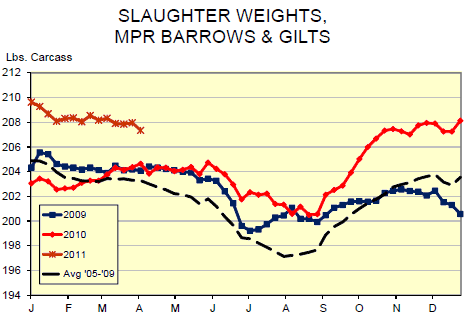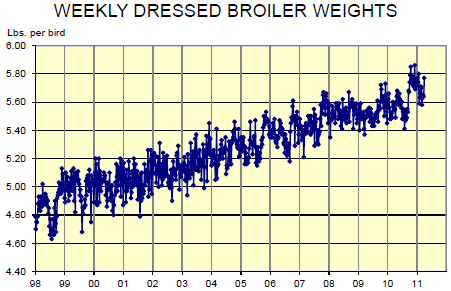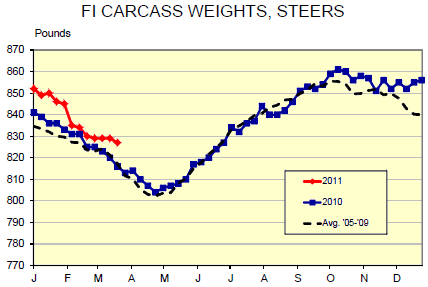



CME: Does Expensive Feed Mean Lighter Animals?
US - USDA's second Crop Progress report of 2011 was released today, write Steve Meyer and Len Steiner.Crop “progress” in these early reports is generally limited to planting progress with three exceptions. The report includes emergence data for oats and rice and state crop condition ratings for winter wheat which should just be emerging dormancy in most areas. Obviously, the wheat conditions are the most important of these data to livestock producers as wheat can be substituted into hog, cattle and poultry diets if it is priced low enough relative to corn.
And the news is not good for winter wheat conditions. For the 18 key states, only 36 per cent of the acres are rated Good or Excellent. That compares to 37 per cent last week and 65 per cent last year. At the other end, 36 per cent of acres are rated as Poor or Very Poor. That compares to 32 per cent last week and only 6 per cent one year ago. As we alluded to on Friday, the big problems are in the southern plains. 66 per cent of Texas’s wheat acres are rated poor or very poor as are 60 per cent of Oklahoma wheat acres, 37 per cent of Kansas acres and 57 per cent of Colorado acres. Those states ranked 2nd, 3rd, 1st and 5th, respectively, in winter wheat production and hard winter wheat accounted for 42 per cent of total U.S. wheat production in 2010.
Corn planting is just getting underway with only 3 per cent of total corn acres planted. That number is the same as last year and the 5- year average. Virtually all of those acrese, of course, are in the south and Delta regions and no states appear to be running into any major difficulties yet. Texas is the farthest along at 47 per cent (compared to a 5-year average of 58 per cent for the first full week of April) and North Carolina has 31 per cent of its acres planted relative to a 5-year average of 27 per cent. One note: These southern corn growing areas may take on greater importance this year given the low projected carryout stocks. Where 2010 crop corn was pulled forward due to quality issues last fall, 2011 crop corn could well be pulled forward due to availability issues this year.
Market weights of virtually every meat and poultry producing animal have defied the logic of “expensive feed means lighter animals” over the past few months. While the may not make sense to us observers, our experience is that producers know what they are doing and it is us observers who need to re-think our criticism when the real world does not match out expectations. In the case of market weights, we believe a bit more investigation again confirms that experience.
Take market hog weights, for example. They normally rise in the fall of the year when new crop corn becomes available and temperatures cool. New crop corn usually tastes better and, being fresher, has higher nutrient content and availability. Cool weather and palatability encourage consumption, more and more-available nutrients enhance conversion. All were true in spades last fall due to the very poor quality of the 2009 corn crop — and the impact of that crop can be seen by the anemic seasonal increase in weights in the fall of 2009.

Those factors are still in play on pork operations PLUS cash hog prices are high enough to compensate producers for the additional cost of an added pound. For us econo-geeks, MR > MC so output should be increased. In addition, roughly 2 million slack finishing spaces (relative to 2008) are allowing producers to leave slower-gaining pigs on feed longer and driving the bottom end of the weight distribution upward. In years past, the need to put new pigs in those finishing spaces would have driven those slow doing pigs to be sold and slaughtered as under-weight pigs which are sometimes referred to as off hogs or junk hogs. The smaller cuts from these smaller pigs, though, are preferred by many ethnic markets.
As can be seen, broiler weights have jumped since last year as well but the driver here is a fundamental shift in the broiler business to heavier birds. The broiler sector is really two sectors — light birds used for whole broilers or bone-in chicken parts in restaurants and heavy birds that are boned out primarily for their breast meat. The latter has depended on export markets to capture value of dark meat portions. Export challenges with Russia and Russia’s stated intent of self-sufficiency have called this model into question in the long run but the industry is still moving in that direction in spite of higher feed costs. At least for now.

Finally, cattle weights have indeed risen versus last year and the 5-year average but by much less than have hogs or broilers, with both steers (see below) and heifers averaging about 1 per cent higher so far in 2011. Recent fed cattle prices are high enough to take cattle to even higher weights in spite of high costs of gain but robust demand for cattle have kept them moving to slaughter before weights can get much higher. “Take these cattle prices before they are gone” would be a reasonable characterization of many feeders’ current thinking!









